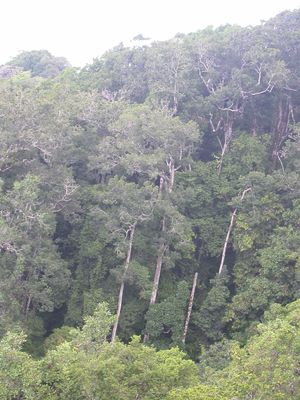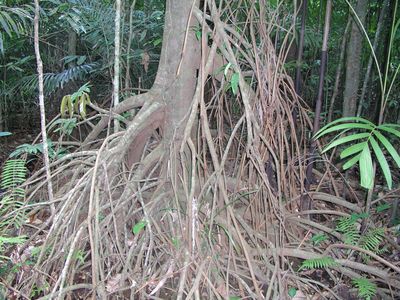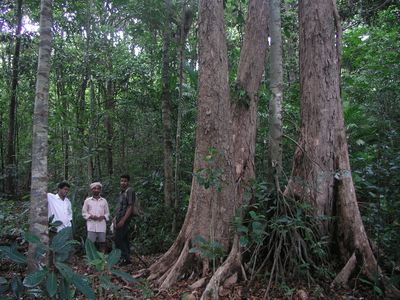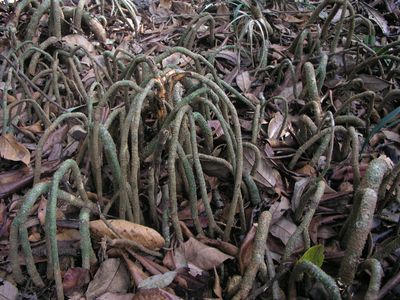 |
WESTERN GHATS: IN SEARCH OF THE PRIMEVAL
|
 |
Email: mds@ces.iisc.ac.in, cestvr@ces.iisc.ac.in
1 Member, Karnataka Biodiversity Board, Government of Karnataka, 2 Member, Western Ghats Task Force, Government of Karnataka
| l | l | l |
About four millennia ago everything about Western Ghats, one of the 34 global biodiversity hotspots along with Sri Lanka, would have been in its pristine glory. Clad in a range of forests from the tropical evergreen to dry deciduous, and its colder heights of rolling grasslands and stunted evergreen shola woods often enveloped in mists and clouds, the Western Ghats stood untrammeled until agricultural beginnings. This was just over three millennia ago, when major civilizations of the world- in Egypt, Mesopotamia and Indus- were in decadence. Streams and rivers running perennially, waterfalls in their unceasing grandeur till late, everything about it was primary although human influence on Western Ghats began some 15-20 thousand years ago with hunter-gatherer colonization, in great contrast to hominids arrival in the South Indian plains over 1.2 million years ago. Abundant in edible fruits and seeds, tubers, palm juice and starch, wild grains etc. and landscapes teeming with wildlife, the pre-agricultural humans faced no difficulty in food gathering, fishing and hunting. They, the ancestors of the Irulas, Kanis, Katunaikans, Kolis, Kurichias, Kurubas, Malai-arayans, Malapandarams, Malaikudiyas, Muthuvans, Paniyas, Soligas, Todas and dozens of other hill tribes lived in harmony with the pulsations of the complex wilderness of a rugged terrain. Closeted in endogamous groups they lived in primeval forests amidst fear-stalking animals like elephants, tigers, panthers, bears, and serpents. They developed their own cultures, and biological knowledge that enriched the South Indian ayurvedic tradition of later times. The Todas moved to the shola forest-grassland complex of the Nilgiri mountains and took to buffalo raising in later times.
The early tribes were cosmocentric nature worshippers, who prayed not just to forests or trees, but a whole system where the mountain peaks were prominent. The brooks that rushed down the heights, the forests, many animals and the spirits of departed ancestors, though worshipped separately, were integral to the mountain system. They did not separate the spirit from the matter, but adored them in totality as a divine being. The list of hills and mountains venerated from time immemorial is too long- Agastyamala, Sabarimala, Kotamala, Muthanmala, Thalakaveribetta, Biligirirangan and so on.
During the peak of Egyptian, Mesopotamian and Indus Valley civilizations at 2000 B.C., Deccan plateau awakened to agriculture and pastoralism. By 1000 B.C. these civilizations were on the decline, due to reasons that might include climatic change, alien invasions, decline of soil fertility, shifting of river courses etc. There was possibly a southward migration of the Indus people as worship of mother goddess, Shiva, and serpent integral to the Western Ghat-west coast today had their prototypes in the Indus Valley. Pollen studies reveal that around 1500 B.C. there was increase in savanna plants and decrease in forest trees pollen in the central Western Ghats, probably due to forest clearances for agriculture and cattle keeping.
Shifting cultivation, by names kumri or punam, as against permanent cultivation was early agricultural system in the humid lower altitudes of Western Ghats, that withstood pest pressures, soil erosion and loss of fertility if fallow period was long after two to four years of cultivation, permitting return of the forests. Along the coast, where population density was higher, probably increased impact on the coastal hills, as in Canara and Malabar, would have caused extensive laterisation making the terrain bereft of soil and unfit for further cultivation (Fig.1). The repeated harvests of firewood and timber and burning of rank growth for promoting grasses also caused laterisation.
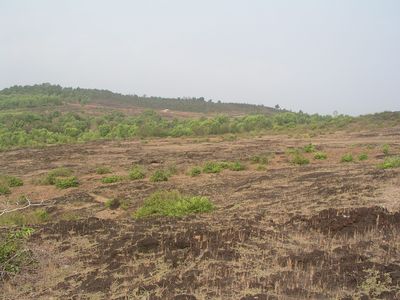
Fig.1. Laterisation of coastal hill in Uttara Kannada
During his tour of Malabar and Canara in 1800-01, after Tipu Sultan’s defeat, Francis Buchanan, Lord Wellington’s emissary, described laterite from Angadipuram in Kerala, where stands a silent memorial in laterite dedicated to him. While coastal and interior hills of Canara were under slash and burn cultivation, and much of them were already desolate and rocky, Buchanan also found stately evergreen forests spontaneously producing pepper, the menasu-kans. The most priced export commodity from the west coast since early Roman times, the kan forests were important sources of spontaneous pepper production in the central Western Ghats region, just like forests that produced cardamom in Travancore. With no tree being normally cut, for fear of offending gods, these sacred kansthey remained primeval in nature, which almost every village had at least one. Despite passage of time the remains of some these kans, dark green and high with towering trees (Fig.2), give the impression to the passerby that there is some god resident in it. Apart from pepper, cinnamon, fruits and seeds, and palm toddy and other non-timber products were collected under a decentralized system of regulated harvests. The sacred forests were sources of streams and as well moderated local climate. To Buchanan the locals near Karwar conferred: “The forests are the property of the gods of the villages in which they are situated, and the trees ought not to be cut without having leave from the Gauda, or headman of the village…. who here also is priest (pujari) to the temple of the village god.”
Buchanan doubted the claim of sacredness as a contrivance of the natives against state takeover forest resources. Except acknowledging sacredness of the devarakadus of Coorg, the British consolidated their hold over all common lands, which included sacred forests, shifting cultivation fields and fallows, secondary forests and even grasslands and scrub, wherever people lacked ownership records. The ban on shifting cultivation in late 1800’s, for its alleged destruction of timber resources reduced the role of fire as an ecological factor favouring return of the evergreen forests in the fallows and secondary forests. The rank growth of vegetation all around swamped primary forests making them practically indistinguishable from the rest. As larger sacred groves in the forest belt lost their special identities, only isolated tiny groves, within hamlets and towns, along densely settled coast, under private ownership, or in temple premises, remained as sacred (Fig.3).
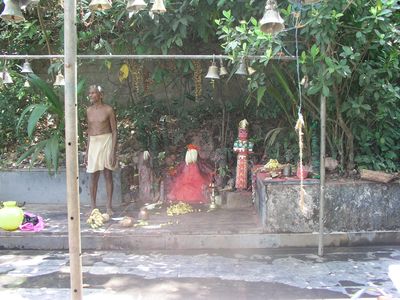
Fig.3. A small coastal sacred grove
The return of evergreens following reduced fire factor shaded and stifled light demanders like teak, rosewood, Terminalias, nandi, etc. Teak was most coveted timber of the time and teak-built warships strengthened the British armada. The foresters saw with consternation lack of teak regeneration under the darkening canopy of evergreens. Grappling with the complexities of rain forest ecology the colonial regime erred by resorting to indiscriminate raising of teak plantations by clear-felling and burning forests, after extracting marketable timbers, causing colossal damages to biodiversity, ecosystems and watersheds. Monocultural plantations continued in post-independent period unsparing even primary forests with millions of years’ evolutionary history.
When recent decades saw rising interest on sacred grove studies with exciting findings, most groves from Kerala showcased as the cultural and biological relics, are entangled fragments of vegetation from households and temples of prominent caste groups of coastal districts, their areas often in fractions of a hectare. Silence reigns the forgotten tribal groves, for instance of Travancore, of which T.F. Bourdillon expressed in 1893: “Many pieces of forests are seen on the hills left untouched when the surrounding land has been cleared…. because they are supposed to be each inhabited by a spirit.” The much larger kan sacred groves of central Western Ghats, of several hectares each, got merged with state reserved forests losing their special identities. They were once abodes of deities, centres of rare biodiversity, storehouse of non-wood products and sources of perennial streams (Fig.4).
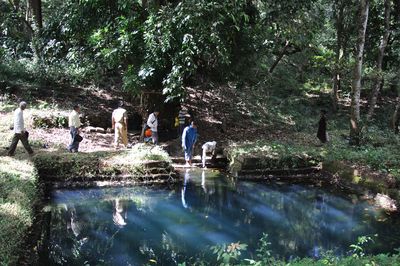
Fig.4. Sacred water body in Sorab kan
The backdrop of ecological history made us prospect for primeval forests in Uttara Kannada where many pre-colonial sacred groves got lost in reserved forests. We discovered about 50 patches of Myristica swamps (Fig.5) of wild nutmeg trees, many associated with deities. Classed among the most primitive flowering plants,the Myristicas had origin in the swamps of Gondwanaland, before the Indian sub-continent parted from it over 100 million years ago. Before intensive agricultural, developmental and forestry interventions the swamps would have networked along the water courses of Western Ghats. Syzygium travancoricum (wild jamun), reported from Travancore, over a century ago by Bourdillon, and considered extinct subsequently, though rediscovered in its home range, has its surprising presence in some of the relic primeval forests of central Western Ghats, over 600 km north of its original range (Fig.6). It occurs along with the Endangered Dipterocarpus indicus, also of Gondwanan lineage. Madhuca bourdillonii, an evergreen counterpart of the Mahua tree, originally from Travancore, and considered extinct later, sparingly occurs in some primeval forest remains.
Adopting forest historical approach we chose for detailed study 2.5 sq.km area of Kathalekan, what apparently was a relic primeval forest in the Siddapur taluk of Uttara Kannada (Fig.7). Meaning ‘dark sacred grove’ in Kannada, Kathalekan’s sanctity goes back to pre-colonial days. Laced with sedate streams this forest harbours endangered Myristica swamps, the forest floor covered characteristically in tangles of aerial roots (Fig.5). Myristica magnifica (Endangered) and Gymnacranthera canarica (Vulnerable) are exlusive to the swamps (Fig. 8 - Fig. 9), along with Syzygium travancoricum (Critically Endangered) and Semecarpus kathalekanensis, a new tree species of mango family described by Dasappa and Swaminath (Fig.10). Apart from Myristicaceae members Kathalekan is dominated by dipterocarps, rare palms, aroids and ferns reminiscent of equatorial Asian rain forests. The tree biomass and carbon sequestration of streams and swamps were higher than that of hill slopes and tops indicating that lakhs of Western Ghats watercourses, if their ecology well protected, can fulfill water demands of Indian peninsula and also mitigate climatic change (Table-1; Fig.11). The adoption of watershed-based forest management system can rejuvenate our water bodies and conserve fragile rain forest ecosystems.
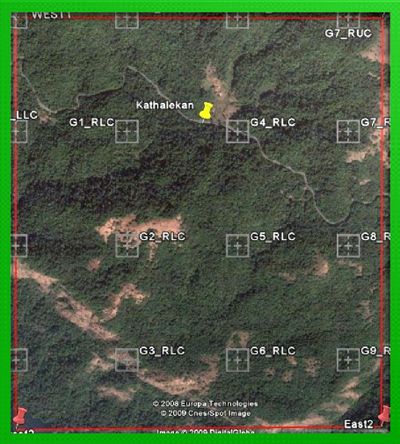
Fig.7: Google Earth view of 2.5 sq.km area of Kathalekan primary forest relics with Myristica swamps (dark green areas)
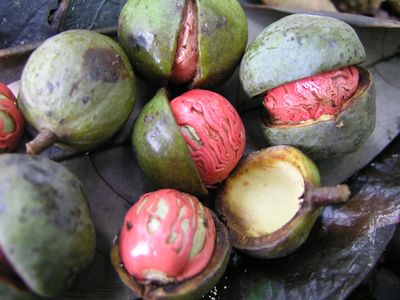
Fig.9. Gymnacranthera canarica seeds
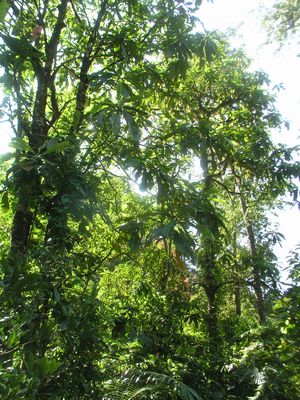
Fig.10. Semecarpus kathalekanenesis
Table-1: Estimated above ground tree biomass/hectare and carbon storage/hectare in water course other forest samples of Kathalekan –water course forests have more biomass and higher carbon storage
| Grid no | Aboveground tree biomass t/ha | Above ground carbon storage in trees t/ha | ||
| Water-course forests | Non-water course forests | Water-course forests | Non-water course forests | |
| 1 | 289.85 | 219.03 | 145 | 110 |
| 2 | 268.53 | 262.58 | 134 | 131 |
| 3 | 594.51 | 305.09 | 297 | 153 |
| 4 | 411.45 | 240.42 | 206 | 120 |
| 5 | 291.92 | 267.28 | 146 | 134 |
| 6 | 269.43 | 342.04 | 135 | 171 |
| 7 | 212.78 | 190.72 | 106 | 95 |
| 8 | 370.41 | 276.80 | 185 | 138 |
| 9 | 436.80 | 265.88 | 218 | 133 |
| Mean | 349.52 | 263.32 | 174.76 | 131.66 |
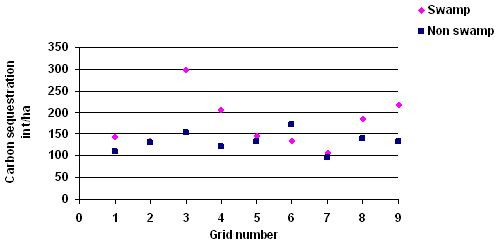
Figure-11: Higher carbon storage in above ground tree biomass of water course forests (swamp) compared to others (non-swamp) in Kathalekan primary forest
The primary forests of Kathalekan and neighbourhood constitute the northernmost range in the Western Ghats for the Endangered primate Lion-tailed macaque. Recent field investigations by our team recorded 35 species of amphibians in just 2.5 sq.km area of Kathalekan, that equals almost the entire amphibian diversity reported from Maharashtra!. Of these 26 species were Western Ghat endemics. Philatus ponmudi, a tree frog is Critically Enadangered and Minervarya sahyadris, Nyctibatrachus aliciae, Pedostibus tuberculosis, Phylatus wynaadensis and P. neelanetrus are Endangered.
The village communities of the Western Ghats had significant roles in the conservation of primeval forest patches as sacred groves. As cultural changes and modernism are sweeping through the region, these communities too are tempted to be on par with others in the plains in belief systems. The gods of the groves are often seen as incarnations or forms of Shiva and Parvati or Subramanya and Ayyappa, or as their guardians, the bhutaganas. The serpent cult and worship of tiger deity, intricately linked to sacred groves are getting merged with Shaivism. Such cultural syncretism is often followed by construction of temples or shrines and the groves conserved through ages fade away, often their tree growth liquidated.
Over two decades ago, on our visit to Mattigar- a small, sedate village of Karivokkaligas, in southern Uttara Kannada, largely cleared for agriculture, we were drawn to a grove, a fragment of the original rain forest, tall, cool and dark and over a hectare in extent. As Prof. Donald Hughes, renowned environmental historian in our team, was curious as to the absence of shrine or an image of god within the grove, an old Karivokkaliga peasant, explained: “The gods there live among the trees.” Mattigar sacred grove has a rare population of the dhupa tree, Vateria indica, the only place in Uttara Kannada where its natural population exists, despite the district having 6500 sq.km under forests. There also are few majestic individuals of Syzygium travancoricum,which has saplings springing from the humus rich damp and shaded floor. When the locals pleaded for safeguarding their grove from cattle and trespassers we made a barbed-wire fencing around it. Recent study, twenty years later, the Western Ghat endemic tree population within the grove had increased by nearly 20 percent! Fragments of primeval forests, which may be often sacred groves, wherever they remain, despite rising human onslaughts on nature, should be resurrected from the backyard of cultural history and placed in the forefront of a decentralised, community based conservation network.
Acknowledgement: We thank our team members Vishnu Mukri, G R Rao, Rajasri Ray, Gururaja K V for inputs based on the field research. Our research in Western Ghats is funded by the Ministry of Environment and Forests, Government of India.
| * Corresponding Author : | |||
| Dr. T.V. Ramachandra Energy & Wetlands Research Group, Centre for Ecological Sciences, Indian Institute of Science, Bangalore – 560 012, INDIA. Tel : 91-80-23600985 / 22932506 / 22933099, Fax : 91-80-23601428 / 23600085 / 23600683 [CES-TVR] E-mail : cestvr@ces.iisc.ac.in, energy@ces.iisc.ac.in, Web : http://wgbis.ces.iisc.ac.in/energy |
|||
